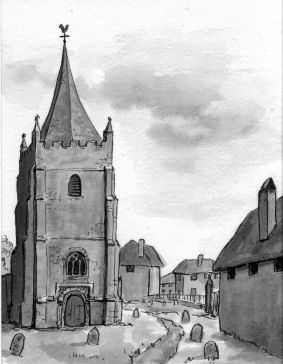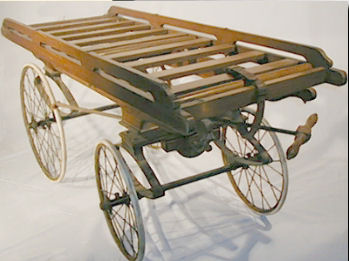

|
If there was an Old Saxon church present in the time of Domesday, it would have been of built of wood, and no trace would remain. Around 1250AD, a Norman church, consisting of a round-ended chancel and a long nave took the place of any earlier building. A hundred years later, a longer nave, in the early English style, and extended on one side had replaced the earlier one. Four pointed arches were also to create an aisle. There are few stones left of the Norman work, but half of the south wall of the chancel is early English. Three of the granite capitals of the 1250 pillars also remain. They are three feet square, with rounded corners, and form part of the basement of the tower buttresses. The true list of vicars begins in 1255. In 1354, the status and endowment of "Rectory" passed to the Abbey of Cannington in Somerset. From then on until the dissolution, the Prioress of the Abbey appointed the Rectors. In 1427, the Abbey wanted even more from Witheridge, but the Bishop of Exeter rejected the application, and, in an Agreement of 1428, safeguarded enough land for the endowment of a Perpetual Vicarage for Witheridge. There have been Vicars ever since, and the glebe was increased in later years by the gift of some 20 acres near South Coombe. The wording of the 1428 Deed would suggest a church in good repair, and by that date the church had been rebuilt in its present perpendicular style. In 1568, thanks to a legacy from Joan Melhuish, the building of the church tower commenced, and included a spire which was as a feature of the local landscape, and which remained until taken down in 1835. In 1721, the church suffered from neglect, for the Vicar, Rev John Shebbear, reported that the roof was so defective that every time there was a shower the Book of Common Prayer got wet. In 1817, a gallery for the musicians and singers was added at the back of the church, a new cello, flute and clarinet were purchased, and the violins restrung. The church continued to pay rent for the Poor House, swept its chimneys, and kept it thatched. In 1840, lightning destroyed the shingled spire, and, instead of replacing it, they increased the height of the tower by 40 feet at a cost of £150, and this resulted to a lot of expense in the next few years. 1840-41: Paid Mr Thomas towards the repair of the tower £150. 1841-42: Paid Mr Bassett for fresh hanging the bells £25.5s. 1842-43: Paid Thomas Western his bill £51.5s.6d. 1842-43: Paid John Brawn Carpenter his bill £47.17.4d. Also in 1840, the eight dwellings in Church lane, which constituted the "Poor House" were demolished to allow the new Turnpike Road from South Molton to enter the village. The following picture is of the Witheridge Funeral Bier from the 19th century, which now resided in Tiverton Museum. It was pulled by means of a metal and wooden handle, and was used for carrying the coffins of people who were too poor to afford a proper funeral, but who would still have been buried in the village churchyard.
Towards the end of the 19th Century Benson Vicars spent generously on the church. The screen and "High Pews" went, the gallery went, and the musicians with it. Windows went and stained glass installed, the chancel altered, and in 1884, an organ and organ chamber were provided along with a vestry. At the same time some memorial tablets were disposed of, including William Chapple's tribute to his father. In 1882, George Cutcliffe of Coombe presented the new Church Clock, and Mr Baker, the Blacksmith purchased the ironwork of the old one for 7/6d. By the 1890's oil lamps and a coke stove were also in place. Changes in 20th Century included the removal of the pews to create Sunday school and Mothers Union Chapels. Modern heating and lighting replaced the oil and coke heating, and the tower needed strengthening at considerable cost, having proved unequal to the task of sustaining the additional weight imposed on it in 1841. Previous Last Edited 03/07/2006 Copyright © 2000-2006 Witheridge Unless otherwise indicated on the page in question, the photographic images reproduced on this site belong to the Witheridge Archives, and, as such may not be reproduced for commercial purposes without written permission. However, you are welcome to use any of the photographs belonging to the archive for personal and/or non-commercial use. Any material shown as not being owned by the archive may not be reproduced in any form without first receiving written permission from the owner of the material in question. The copyright for the illustration of the Church in 1757 belongs to Witheridge Artist and Illustrator Jenny Bidgood. The picture of the Witheridge Funeral Bier is reproduced with thanks to Tiverton Museum. |



